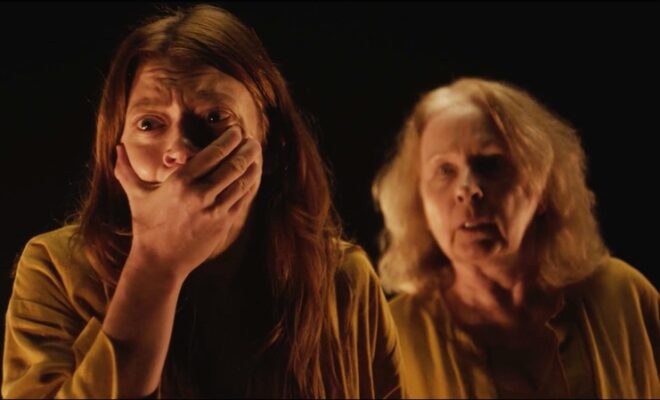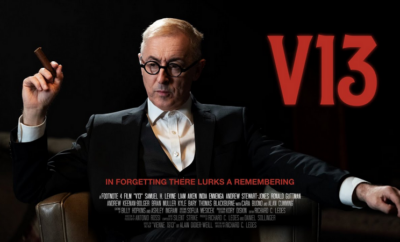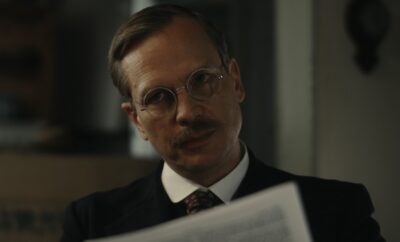 Cailin Yatsko
Cailin Yatsko
Movie Reviews
The Surrender
By: Kelly Kearney
The first rule of bringing back the dead? Don’t. They never return the same. The desperate battle between grief and letting go takes a chilling turn in Julia Max’s feature debut The Surrender premiering at this year’s SXSW. What begins as a supernatural horror story quickly evolves into something far more unnerving—a meditation on loss, trauma and the consequences of clinging too tightly to the past.
At its core, The Surrender is about a fractured mother-daughter relationship, one already strained under the weight of grief. After the death of the family patriarch, Megan (Colby Minifie) and her mother Barbara (Kate Burton) are left to navigate their sorrow in vastly different ways. While Megan turns inward, exhausted from caring for her dying father Robert (Vaughn Armstrong), her mother seeks an impossible solution—resurrection. Pouring her life savings into the hands of a mysterious stranger (Neil Sandilands), she plunges into a ritual that spirals horrifically out of control, placing both women’s lives in danger. As reality distorts and the supernatural takes hold, the two are forced to confront not just the literal horror that unfolds, but also the lingering pain of the past, and in Megan’s case, the misunderstandings of childhood..
Horror Meets Heartbreak
From its opening moments, The Surrender refuses to offer comfort. The first image assaults the senses: a grotesque, inhuman figure feasting on the flesh of the dead. The sickening squelch of tearing skin and dripping blood sets the tone for a film that appears to be an all-out horror bloodbath, but first-time director Julia Max has no intention of delivering a traditional monster movie. Instead, she peels back the layers of the genre, revealing a deeply emotional undercurrent to an experience we all must go through.
Horror is often about survival, but this film asks a different question: What happens when survival is too painful to endure? When we first meet Megan, red-haired and perpetually flannel-clad, she is suffocating under the weight of responsibility. In the film’s opening moments, she bolts out of the house in her slippers, running into the woods, screaming into the void, a cigarette—her only reprieve from the heartbreak of watching her father fade away. That exhaustion sets a tone that lingers throughout the film, even as supernatural forces threaten her life..
Barbara, meanwhile, refuses to surrender to grief, but in trying to bring her husband back she unleashes something neither of them can control. The ensuing horror is less about monsters and more about the things we do, and sometimes become, when we’re not ready to say goodbye.
Colby Minifie: Terror and Tears
Colby Minifie delivers a gut-wrenching performance as Megan, balancing raw vulnerability with simmering rage. One of the film’s most devastating moments unfolds not in the presence of supernatural horror – although this film has plenty of that, but in the aftermath of a mother-daughter confrontation. The fight is as physical as it is emotional. Blame is thrown like daggers, accusations cut deep and the cold distance between them becomes nearly unbearable. Yet it’s in a quieter moment of realization where Minifie truly shines. When Megan finally surrenders to acceptance, the emotions that flood her face are impossible to contain—agony, release, resignation. It’s a rare horror film that allows its protagonist this level of emotional depth and Minifie’s portrayal is nothing short of haunting.
Volleying that emotional turmoil back and forth, Kate Burton delivers a powerhouse performance as a mother so consumed by grief that she is willing to risk everything—even her own daughter. Layered in sorrow and desperation, her portrayal is hauntingly real, capturing the blind determination of a woman who refuses to accept loss.
Burton and Minifie share an on-screen chemistry that feels deeply lived-in, mirroring the raw, often painful dynamics of a real mother-daughter relationship. Their interactions bleed authenticity, filled with unspoken wounds, buried resentment and fleeting tenderness among the violence of this undead ritual. Together they create a familial history that extends beyond the margins of the script—one that lingers in the space between arguments, in the weight of every glance and in the aching pauses where words fail but a simple touch can speak volumes.
A First-Time Director Who Breaks the Rules
Julia Max makes her directorial debut with The Surrender, but you’d never guess it. Her confident, deliberate storytelling suggests the hand of a seasoned filmmaker, someone who understands that true horror isn’t just about what lurks in the shadows—it’s about the weight of grief, the unbearable silence of loss and the desperation to turn back time. Not only did Max direct, but she also penned the script and produced the film alongside an impressive team built of Mia Chang (It Follows), Lovell Holder (Lavender Men), Ian McDonald (Woman of the Hour) and Robert J. Ulrich (“The Boys”).
Rather than relying on traditional horror tropes, Max weaves a suffocating psychological nightmare rooted in emotional devastation. The film’s setting—primarily confined to the family home—feels like a tomb, its walls closing in on the mother and daughter at its core. Every shadowy figure stretching across the dimly lit halls and haunting reflections seen in mirrors, adds to the film’s relentless unease. The house itself seems haunted, not by spirits, but by the oppressive weight of unresolved pain. It is a prison where grief festers, consuming both women in different ways—one surrendering to it, the other desperately trying to escape it.
Escape; however, is fleeting. The only moments of release come when Megan physically breaks free—bolting into the woods, screaming into the void, seeking solace in a stolen cigarette. These brief, chaotic bursts of freedom contrast starkly with the film’s otherwise suffocating stillness. But even in those quieter moments, Max never lets the tension dissipate. Instead, it simmers beneath every glance, every hesitation, every breath held too long. The horror in The Surrender is not just about the grotesque imagery that punctuates its most chilling scenes; it’s about the terrifying, all-consuming grip of grief and what it can drive a person to do.
For her first feature in the genre, Max’s vision extends beyond just creating fear—she crafts an emotional experience that lingers long after the credits roll. Her direction refuses to solely rely on cheap jump scares or excessive gore to unsettle the audience and instead employs a slow, creeping dread that seeps into every frame, making viewers feel the same claustrophobic despair as her characters. If The Surrender is any indication, Max is a filmmaker to watch. She doesn’t just tell a horror story—she immerses us in it, forcing us to confront the terrifying reality of grief, loss and the dangerous allure of trying to rewrite fate. With such a commanding debut, she proves that horror is at its most powerful when it’s deeply, painfully human.
Final Verdict: A Horror Film That Cuts Deep
What sets The Surrender apart from standard horror fare is its refusal to conform to expectation. The real terror isn’t in the blood-soaked rituals or grotesque resurrections—it’s in the pain of life and its slow crawl to the grave. In an oversaturated horror landscape, this 2025 SXSW entry stands out by daring to be something more than just scary. It weaponizes grief in a way that lingers long after the credits roll, challenging its audience to sit with the discomfort of loss rather than escape it. For those expecting a straightforward zombie film, it will surprise and unsettle you, as it replaces mindless carnage with psychological depth, proving that the scariest monsters are often the ones we create in our minds. If you’re looking for a horror film that doesn’t just frighten but sticks with you, The Surrender is one you won’t want to miss.
Covered at SXSW 2025





You must be logged in to post a comment Login